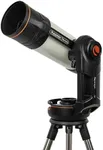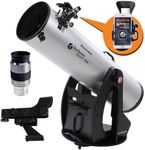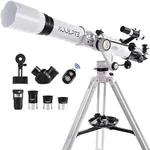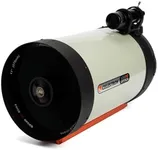Buying Guide for the Best Celestron Telescopes
Choosing the right telescope can be a thrilling yet daunting task, especially if you're new to stargazing. The key to finding the best telescope for you is to understand the different specifications and how they align with your needs and interests. Whether you're a beginner looking to explore the night sky or an experienced astronomer seeking advanced features, knowing what to look for will help you make an informed decision.ApertureAperture refers to the diameter of the telescope's main optical component (the lens or mirror). It is one of the most important specs because it determines how much light the telescope can gather. A larger aperture allows you to see fainter objects and more detail. For beginners, an aperture of 70-100mm is usually sufficient for viewing the moon and planets. Intermediate users might prefer 100-200mm for deeper sky objects, while advanced users often go for 200mm or more to observe distant galaxies and nebulae.
Focal LengthFocal length is the distance between the telescope's main lens or mirror and the point where it forms an image. This spec affects the magnification and field of view. A longer focal length provides higher magnification, which is great for viewing planets and the moon. Shorter focal lengths offer a wider field of view, making them better for observing star clusters and galaxies. Beginners might start with a focal length of 400-800mm, while more experienced users might choose 1000mm or more depending on their specific interests.
MagnificationMagnification is how much larger the telescope can make objects appear. It is determined by dividing the focal length of the telescope by the focal length of the eyepiece. While high magnification can be tempting, it's important to remember that too much magnification can make images blurry. A good rule of thumb is to use 50x magnification per inch of aperture. Beginners should start with lower magnifications (20x-50x) to get clear, stable images, while more advanced users can experiment with higher magnifications for detailed views of planets and the moon.
Mount TypeThe mount is what holds the telescope and allows you to point it at different parts of the sky. There are two main types: altazimuth and equatorial. Altazimuth mounts are simpler and easier to use, making them ideal for beginners. Equatorial mounts are more complex but allow for more precise tracking of celestial objects, which is useful for astrophotography and advanced observations. Choose a mount based on your experience level and whether you plan to do more casual viewing or detailed study.
PortabilityPortability refers to how easy it is to transport and set up the telescope. This is important if you plan to take your telescope to different locations or if you have limited storage space. Smaller, lighter telescopes are easier to move and set up, making them ideal for beginners and those who travel frequently. Larger telescopes offer better performance but can be cumbersome to transport. Consider your lifestyle and how often you plan to move your telescope when making your choice.
Optical DesignTelescopes come in different optical designs, including refractors, reflectors, and compound (catadioptric) telescopes. Refractors use lenses and are known for their sharp images and low maintenance, making them great for beginners. Reflectors use mirrors and offer larger apertures at a lower cost, ideal for deep-sky viewing. Compound telescopes combine lenses and mirrors, providing versatility and compactness, suitable for both beginners and advanced users. Choose an optical design based on your viewing preferences and maintenance willingness.




















